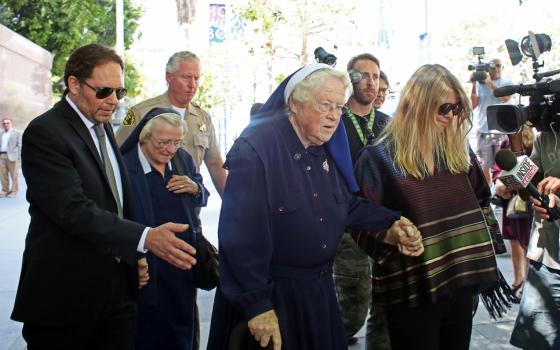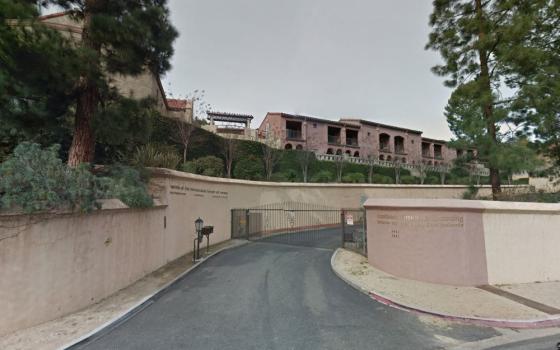This summer, Sisters of the Immaculate Heart of Mary have made national headlines over their conflict with the Archdiocese of Los Angeles about who had the right to sell the sisters’ villa-style convent in the city’s hip Los Feliz neighborhood. The 22,000-square-foot property, which boasts views of downtown Los Angeles and the San Gabriel Mountains, caught the eye of pop singer Katy Perry, who reportedly has plans to “sip green tea and find herself” in the property’s meditation garden.
The archdiocese attempted to sell the property to Perry for about $14.5 million, but at the same time, two of the last five living IHM sisters tried a sale of their own, to local restaurateur Dana Hollister, for $15.5 million. The story — Nuns in Fight with Katy Perry — or some iteration of that, found its way to just about every news outlet imaginable: The New York Times, “Good Morning America” and, of course, the Los Angeles Times, which broke the story.
The conflict centers on who officially controls the property, and, therefore, who has a right to sell it. The IHM sisters already have a conflicted history with the archdiocese: In 1970 around 90 percent of them left the order as a result of a dispute with then-Archbishop Cardinal James McIntyre over efforts the sisters were making to modernize following Vatican II. The sisters who left the order formed an independent lay community called the Immaculate Heart Community. Of those who remained in the order, only five are still living.
In 2005, the Vatican decided to appoint a pontifical commissary within the archdiocese, then headed by Cardinal Roger Mahony, to assume responsibility for the remaining sisters and make sure they were taken care of in retirement — much like a legal guardian would. In 2011, all five sisters left the convent building and now live in various retirement communities.
Many think that the nature of the commissary role means that the sisters lost control over their right to sell the property. However, the sisters’ attorneys say the archbishop acted illegally and "as if he were above the rules and immune from the obligations of civil law.” The archdiocese sued to prevent the sale to Hollister, and the sisters in turn filed for a temporary restraining order against the archdiocese.
A California judge invalidated the nuns’ deal with Hollister July 30, but did not allow the sale to Perry either. The next hearing in the case, which the judge said may take two years to resolve, is scheduled for September.
Securing retirement
The story of the IHM sisters in Los Angeles speaks to larger issues: What are the property rights of women religious, and what can happen when conflicts over property arise? Whether it is a school, hospital, thrift store or herd of livestock, property ownership has been a central component to most religious institutions throughout history, especially in the United States. And for women religious, the assets they own can make or break a secure retirement. This issue is of the utmost importance today, because of the rapid increase in age and decrease in membership most religious orders are facing. The Center for Applied Research in the Apostolate at Georgetown University found that, in the last 50 years, the number of nuns in America has declined by over 70 percent.
Mercy Sr. Sharon Euart, who holds a doctorate in canon law, says sisters are increasingly concerned about having enough resources for retirement and for supporting elderly sisters in their orders. “If a community doesn’t have the resources to care for their sick and retired, that’s a very difficult position to be in,” she says. It’s not uncommon for elderly sisters to be living off income generated from property owned by the religious institution. This, of course, is the only option for property ownership for sisters. Taking the vow of poverty and abstaining from owning anything individually can be “very scary, especially for small communities,” she says. In these cases, sisters sometimes have to rely on donations collected by the National Religious Retirement Office which, Euart says, “helps towards their retirement but doesn’t pay the full amount needed.”
In Los Angeles, the office of the archdiocese has said publicly that any revenue generated from the sale of the IHM sisters’ convent will go back to the sisters. But, writes Steve Lopez in the LA Times: “[The sisters] pooled their money and bought the property decades ago at a discount from a benefactor, and their biggest fear is that if the diocese cashes in on a sale, the sisters' living expenses will not be covered. The archdiocese insists that's not the case at all, but sisters Rita [Callahan] and Catherine Rose [Holzman] don't trust that promise.”
Patrick Wall, a canon lawyer based in Minneapolis, Minnesota, says that the personal relationship between the head of a community of women religious and a bishop can affect how sales of property are handled — and how property was incorporated in the first place. He offers a historical example, saying that in St. Paul, Minnesota, the mother superior of the Sisters of St. Joseph of Carondelet was also the biological sister of former Archbishop John Ireland, who served as archbishop from 1888 to 1918. “All the colleges the sisters set up were all independently theirs,” he says, because of the relationship between siblings.
With 195 dioceses in the United States and about 3,000 worldwide, situations around property ownership vary greatly depending on the specific relationships — and the relationships are not always harmonious. “It does happen that a priest or a nun will do a business contract, and somebody at the chancery will step in,” says Wall. Another issue is that a religious order owns a particular business, such as a school or a hospital, but the diocese owns the land on which the business resides — which can make matters like sales of property confusing.
Furthermore, even determining who owns the property can sometimes present a challenge. “In some cases we’re talking about property the church has owned since the 17th century — before the U.S. existed,” says Wall. “A case like that could obviously present a clear title problem.”
In the United States, most property disputes between religious orders and bishops involve hospitals, says Wall. There has been a trend in recent years, as religious orders age and downsize, of the orders selling hospitals to secular nonprofit and for-profit groups. This can result in disputes with bishops, who tend to be concerned with maintaining Catholic values in hospitals, he says.
A well-known example of a sale to a non-profit corporation is St. Marys Hospital in Rochester, Minnesota, which is now the Mayo Clinic Hospital, St. Marys campus. Sisters have the right to make these sales, but “bishops get nervous because they aren’t able to control these hospitals like they were when the nuns technically owned them. Bishops are concerned about doctrinal issues,” Wall explains. As a result, the sales don’t always go through.
In 1996, for example, the St. Louis-based Daughters of Charity faced severe opposition from Cardinal Bernard Law, head of the Boston archdiocese, when the order considered merging its Carney Hospital in Boston with Partners HealthCare System Inc., a nonreligious network of hospitals. (The sisters were so business-savvy that they earned the nickname “Daughters of Currency” on Wall Street.) Law successfully blocked the transition, and the Daughters sold instead to a Catholic system, Caritas Christi.
Navigating disputes
An important thing for sisters to keep in mind, when it comes to disputes with local dioceses around the sale of property, is when it is appropriate and required to involve Rome. Euart says there are certain circumstances in which the Vatican must give permission for a sale, no matter what. These are if the diocese where the property is located has fewer than 500,000 Catholics and the property is sold for more than $5.7 million; and if the diocese has more than 500,000 Catholics and the property is sold for more than $11.4 million.
However, sisters always have recourse to Rome, whether they are a diocesan or pontifical order. Says Sr. Rosemary Smith, a canon lawyer with 35 years of experience and a Sister of Charity of St. Elizabeth: “Even if they are responsible to a particular bishop, if they feel they are not being treated appropriately or they haven’t gotten a hearing or whatever, they can always appeal to the Congregation for Institutes of Consecrated Life.”
The process is extensive, however. There are many documents that need to be filed, and the Vatican will consult with the local bishop, too — rather than just taking an order’s word for it. “It’s cumbersome, takes time and requires resources, but it is recourse that’s always available,” says Smith.
In general, Smith says, property rights conflicts are less common in the United States than in other countries, particularly developing nations. “Now, in the U.S. most religious congregations have internal knowledge or external consultants, like lawyers and real estate agents, who guide them appropriately whenever they enter into any kind of real estate deal.”
“Starting with the Sisters Formation Movement (in the early 1950s), sisters in the United States have known they need to be prepared for more than just good will,” Smith says. She describes Sr. Mary Xavier Mehegan, one of her order’s co-founders, as “a shrewd Irish woman who knew the value of having property.”
When the order purchased its first piece of property in the mid-1800s, the bishop offered to hold the mortgage so the sisters wouldn’t have to worry about the payments, she says. Xavier declined — she wanted it under her control.
“It wasn’t distrust. It was just a little tug-of-war with the bishop. He meant well, but she also knew what her plans were for the future of the congregation. It was worth it to her to tolerate the stress and hardship of paying those mortgage payments,” Smith says. During Xavier’s tenure, the order took on schools, hospitals, nurseries, orphanages, a residence for working women and other properties.
Today, organizations like the Leadership Conference of Women Religious and the Resource Center for Religious Institutes, of which Euart is executive director, can provide assistance to sisters dealing with property rights conflicts and more.
In other countries, particularly developing nations with extremely patriarchal societies, “When the bishop says something, sisters do not question that,” says Smith. “They may have the desire [to own their own property], but don’t have the resources to do that for their sisters.”
Smith shares a hypothetical situation that she says frequently occurs in developing nations: “Say 30 years ago a bishop offers a piece of land to a congregation that’s just starting up. The congregation assumes it’s theirs. They build a motherhouse on it and start a school. Twenty-five years later, the bishop says, ‘I’m taking it back.’ The sisters don’t have the deed; they don’t have the documentation that the law requires.”
“There are instances where congregations have been put out of their motherhouses and lost all their resources,” Smiths says.
Mortgaging a motherhouse
Historically, women religious have not made earning money for their own retirements a priority — rather, they have focused on serving others through their mission. During the 1950s and ‘60s when the number of U.S. sisters peaked, and even into the 1980s, Catholic sisters worked in schools and hospitals for very little financial compensation or even for free. “When they were working as teachers or running hospitals, the sisters essentially worked for pennies and plowed money back into the schools and hospitals they operated. In those boom years they didn’t receive retirement benefits or pay into the Social Security system,” reads an article in the Detroit Free Press about Catholic churches seeking donations for elderly priests and nuns.
Smith says the history of her order, the Sisters of Charity of St. Elizabeth, is in line with this lifestyle. “More than 100 years ago we mortgaged our motherhouse to begin a hospital. It was a big risk, but we understood our mission was for the good of the people we were serving,” she says.
“A lot of [communities of] sisters at that time exchanged assets they had for the purpose of helping their schools, hospitals or orphanages survive. . . . The reason those properties were initially purchased was so they could foster their ministry,” Smith adds.
In Los Angeles, the reasons the IHM sisters gave for opposing the Katy Perry deal were twofold: They object to her public image, but they also believe the deal they made will provide more security for sisters in their retirement. It appears the sisters are concerned with maintaining the spirit of their ministry, even if the order dies with them.
*An earlier version of this photo caption gave incorrect information about the property.
[Georgia Perry is a freelance writer based in Oakland, California. She's contributed to several print and online magazines including, The Atlantic, CityLab, Portland Monthly Magazine and the Portland Mercury. She was formerly a staff writer at the Santa Cruz Weekly in California. Follow her on Twitter @georguhperry.]



